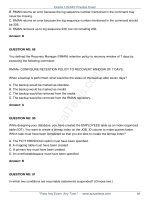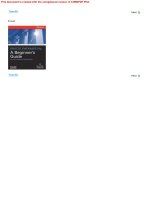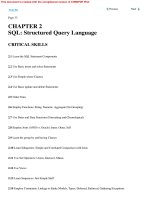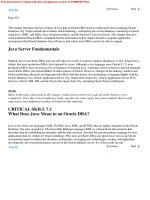Oracle Database 10g A Beginner''''s Guide phần 7 pdf
Bạn đang xem bản rút gọn của tài liệu. Xem và tải ngay bản đầy đủ của tài liệu tại đây (1.46 MB, 29 trang )
The database is not available during the backup.
3. Describe the difference between a logical and a physical backup.
A physical backup is performed by utilities such as RMAN or by a hot or cold backup, and operates on the
underlying database data files. A logical backup, on the other hand, is performed by utilities such as Data Pump
Export or Import and allows for a backup or restore to be performed on logical database structures such as tables or
indexes.
4. Name three different types of backups.
Three different types of backups are physical hot and cold backups, logical backups as implemented by Data Pump
Export/Import, and RMAN backups.
Team Fly
This document is created with the unregistered version of CHM2PDF Pilot
Team Fly
Page 374
10. Are there any disadvantages to an RMAN recovery catalog?
One disadvantage to the recovery catalog is that it must be backed up itself. This is simple since it is a very small
schema.
11. How can default settings be set up by you for future runs of RMAN?
Default settings can be set up by you with the RMAN configure command. Channels can be configured to achieve
optimal performance and other backup configurations can be created to simplify backup and recovery scripts.
12. What is an RMAN backup-set and how does it relate to a backup-piece?
A backup-set is made up of one or more backup-pieces and is what constitutes a full or incremental backup. A
backup-piece is a file that is managed by RMAN.
13. Describe the ways in which corrupt blocks can be recovered.
Individual data blocks can be recovered with the database online and available to users. You need to specify which
block can be recovered and these can be found in the alert log or the v$backup_corruption or v$copy_corruption
views. Block media recovery is only available with RMAN.
14. What are some advantages to incremental image copies?
Incremental image copies save disk space and network resources since the backup files are smaller. They can also
speed up recovery when compared to applying archive logs.
15. When performing a recovery from a hot backup, do all files and tablespaces need to be brought
forward to the same point in time?
All files and tablespaces (except for files in read-only tablespaces) need to be brought forward to the same point in
time.
Chapter 6: PL/SQL
1. Where is PL/SQL executed?
This document is created with the unregistered version of CHM2PDF Pilot
PL/SQL is executed within the confines of the database. It will receive parameters and return data, but all program
execution is performed in the database.
2. Which type of PL/SQL statement would you use to increase the price values by 15 percent for items
with more than 1500 in stock and by 20 percent for items with fewer than 500 in stock?
Team Fly
This document is created with the unregistered version of CHM2PDF Pilot
Team Fly
Page 375
B.
Explanation To be able to perform a validation of your data and then perform one task if the condition is met and
another when the condition is not met, you must use the IF-THEN-ELSE construct.
3. What is the fetch command used for?
The fetch command is used to retrieve data from an open cursor that had been opened previously.
4. What will the following command perform?
It will set the value of the variable to 500.
5. What is wrong with this function definition?
The END clause needs to have the same name as the name of the procedure. This value should be raise_price, not
lower_price.
6. What is the advantage of using the %TYPE attribute when defining PL/SQL variables?
The advantage of using the %TYPE attribute when defining PL/SQL variables is that it links the definition of the
variable to the database definition. It also allows a program to adjust for changes to database structures while
impacting the execution of the PL/SQL program.
7. What Oracle Database 10g facility besides PL/SQL supports exception handling based on error
numbers?
No other Oracle Database 10g facility besides PL/SQL supports exception handling based on error numbers.
8. A commit that is issued in a PL/SQL program will commit what?
All transactions that are currently pending will be committed, unless the commit is issued within an autonomous
transaction.
Chapter 7: Java
This document is created with the unregistered version of CHM2PDF Pilot
1. True or False: One of the benefits of EJBs is that they combine business and user interface logic.
False.
Explanation EJBs contain business logic, not user interface logic. User interface logic is contained in servlets.
Team Fly
This document is created with the unregistered version of CHM2PDF Pilot
Team Fly
Page 377
10. The __________ script is used to configure the Oracle JVM.
The initjvm.sql script is used to configure the Oracle JVM.
Explanation The initjvm.sql script loads the Java classes into the Oracle database and sets up the Oracle JVM in
the Oracle database.
Chapter 8: XML
1. XML stands for Extensible __________ Language.
XML stands for Extensible Markup Language.
2. XML documents are in what type of data structure?
B.
Explanation XML documents tag data using a hierarchical structure.
3. What is the notation used when querying XML documents, which is implemented with Oracle Database
10g?
XPath is the notation used when querying XML documents.
Explanation There are plans to base queries using the XQuery standard.
4. What is a well-formed XML document?
A well-formed XML document is syntactically correct (in other words, there are corresponding end tags for every
start tag).
5. Using the existsnode() function within a SQL query should return what value if the node exists?
D.
This document is created with the unregistered version of CHM2PDF Pilot
Explanation existsnode() returns a Boolean value: 0 if the node is not found, 1 if it is.
6. Of the following four methods listed, which is used to store XML documents in Oracle XML DB?
D.
Explanation For XML document management, Oracle has implemented numerous methods that can access Oracle
XML DB.
7. What is used to ensure that an XML document is valid?
XML Schema is associated to an XML document that defines the structure and data types the XML document must
conform to.
Team Fly
This document is created with the unregistered version of CHM2PDF Pilot
Team Fly
Page 378
8. What is the defined data type that is used to store XML documents in Oracle Database 10g?
XMLType is the defined data type used to store XML documents in Oracle Database 10g.
9. When using xmlagg() function to build an XML type, what SQL clause must it be accompanied by?
When using xmlagg() function to build an XML type, it must be accompanied by a group by clause.
Explanation The group by clause is used to group the result set into a hierarchical structure.
10. What does the acronym XSLT stand for?
C.
Explanation XSLT, or Extensible Stylesheet Language, is used to automatically transform XML-tagged documents
into multiple display formats such as HTML, or into another XML document.
11. What does the acronym SQLX stand for?
A.
Explanation SQLX is the combination of the Structured Query Language used to access relational databases and
XPath, which is used to query XML documents.
Chapter 9: Large Database Features
1. Which of the following is not a valid combination for composite partitioning?
C.
Explanation Range partitioning with list partitioning is not a valid combination for composite partitioning.
2. What data population methods can be used on a compressed table that result in the data being
compressed?
This document is created with the unregistered version of CHM2PDF Pilot
For data to be compressed, it must be bulk loaded into the table or you can issue an alter table statement to
compress existing data.
3. __________ partitioned indexes are defined independently of the data partitions, and __________
partitioned indexes have a one-to-one relationship with the data partitions.
Team Fly
This document is created with the unregistered version of CHM2PDF Pilot
Team Fly
Page 381
Index
Symbols
!= (inequality) operator, using with where clauses, 45
!= (not equals) operator, using with where clauses, 42
() (parentheses), enclosing subqueries in, 72
:=, significance in PL/SQL, 206
^= (inequality) operator, using with where clauses, 45
+ notation in outer joins, significance of, 61
(less than) operator, using with where clauses, 45
= (less than or equal to) operator, using with where clauses, 45
(inequality) operator, using with where clauses, 45
= (equality) operator, using with where clauses, 45
(greater than) operator, using with where clauses, 45
= (greater than or equal to) operator, using with where clauses, 45
; (semicolon)
in PL/SQL IF statements, 225
This document is created with the unregistered version of CHM2PDF Pilot
in SQL statements, 38
A
abort shutdown approach, explanation of, 100
access, controlling with sqlnet.ora file, 154 155
accounts, locking against passwords, 117
ADD_FILE parameter, using with Oracle Data Pump Export, 177
add_months() date function, description of, 54
ADDRESS attribute, setting with dispatchers, 132
ADDRESS parameters in listener.ora, descriptions of, 138
address XML SQL query, definition for, 292
administration tools
command-line utilities, 149 151
OEM Central Console, 148
OEM components, 148
OEM (Oracle Enterprise Manager), 146
Oracle Advanced Security option, 151
Oracle Internet Directory Configuration Assistant, 149
Oracle Net Configuration Assistant, 148 149
Oracle Net Manager, 147
This document is created with the unregistered version of CHM2PDF Pilot
overview of, 146
advisors, role in self-managing databases, 342
aggregation functions
cube, 345 346
overview of, 53
rollup, 344 345
alert logs, backup up, 163
aliases, using with Oracle inner joins, 58 59
alter database command, syntax for, 110
alter statement, using with parallel execution, 330
alter system command, explanation of, 24
alter table abc drop partition xyz command, effect of, 303
alter table command
compressing data with, 325
using with data partitions, 317
alter table statements, purpose of, 34
ALTER USER statement, issuing, 114
analysis functions, ranking functions, 347 352
This document is created with the unregistered version of CHM2PDF Pilot
analytic partitioning, explanation of, 353
analytic window, explanation of, 353
analyze statements, purpose of, 34
analyze table command, relationship to partitioned tables, 304
and logical operator, purpose of, 42
ANSI full outer joins, overview of, 65
ANSI inner joins, overview of, 59 61
ANSI natural joins, overview of, 61
ANSI outer joins, overview of, 64 65
applets in Java, features of, 250
arc0 (archiver) background process, description of, 7
architecture and design, DBA's responsibilities for, 91, 109
archive log current command, effect of, 166
archive log management in RMAN, explanation of, 189
archive logs
backup and recovery considerations, 162
managing, 110
archived redo logs, backing up, 172 173. See also redo logs
This document is created with the unregistered version of CHM2PDF Pilot
Team Fly
This document is created with the unregistered version of CHM2PDF Pilot
Team Fly
Page 382
arithmetic operators, PL/SQL support for, 204 205
as select keywords, using with create view statements, 78
as statement, using with stored procedures in PL/SQL, 234
ASM (Automatic Storage Management)
architecture of, 338 339
benefits of, 341
description of, 26
overview of, 338
ASM disk groups, associating with tables, 340
authority, granting and taking away, 115 116
avg() aggregate function, description of, 53
B
background processes
explanation of, 3
overview of, 6 7
backup and recovery. See also backups; database backup; recovery; RMAN (Recovery Manager); user-managed
backups
This document is created with the unregistered version of CHM2PDF Pilot
cold backups, 164 165
DBA's responsibilities for, 91 92
explanation of, 29
hot backups, 165 166
overview of, 158 159
backup and restore optimization in RMAN, explanation of, 190
backup architecture, overview of, 159 160
backup control files, using for recovery, 169 170
backup sets, listing in RMAN, 191
backup types, overview of, 159
backups. See also backup and recovery; database backup; recovery; RMAN (Recovery Manager); user-managed
backups
of archived redo logs, 172 173
automating, 171
multiplexing in RMAN, 189 190
performing with RMAN, 192 195
BEGIN line in PL/SQL program, significance of, 203
between A and B operator, using with where clauses, 46
between keyword, using with where clauses, 43
This document is created with the unregistered version of CHM2PDF Pilot
binaries in Oracle, backup and recovery considerations, 160
blob data type
versus clob, 15
overview of, 12
block media recovery, performing with RMAN, 191
blocks
backup and recovery considerations, 162
in schemas, 94 95
boolean data type, using in PL/SQL, 208 209
btitle command, effect of, 84
buffer overflow error message, triggering, 235
C
Cache Fusion technology, relationship to RAC, 338
candidate table, analyzing for data partitioning, 305 307
capacity planning, DBA's responsibilities for, 91
CASE statements, using in PL/SQL, 227 228
ceil() numeric function, description of, 52
change management, DBA's responsibilities for, 93
change_password command, using with listeners, 139
This document is created with the unregistered version of CHM2PDF Pilot
channels, allocating automatically with RMAN, 190
character functions, overview of, 51 52
character sets, role in Oracle Net Services, 125
CHECK constraints, description of, 82
checkpoints, backup and recovery considerations, 161 162
CIRCUITS initialization parameter for shared servers, definition of, 131
cjq0 (job queue) background process, description of, 7
ckpt (checkpoint process) background process, description of, 6
CLASS_PATH init.ora parameter, description of, 255
clob data type
versus blob, 15
overview of, 12
close command, using with PL/SQL, 215
Cluster Manager, role in RAC, 337
cman.ora configuration file, description of, 145
cold backups
versus hot backups, 167, 172
overview of, 164 165
This document is created with the unregistered version of CHM2PDF Pilot
recovering from, 167 168
columns
formatting in SQL*Plus, 84
names of, 12
referencing during FOR loops, 216
command-line utilities, overview of, 149 151
comments, adding to PL/SQL programs, 228
comparison operators, using with where clauses, 44 45. See also set operators
complete versus incomplete recovery, 168, 170
composite partitioning, explanation of, 313 314
compressing data, 323 326. See also index key compression
conditions, including in programs, 222 231
configuration files, syntax for, 144 146
configuration settings, managing with RMAN, 190
connect descriptors
defining, 134 135
example of, 134
Connection Manager. See Oracle Connection Manager
This document is created with the unregistered version of CHM2PDF Pilot
connection pooling, overview of, 140
connections
defining, 134 136
maintaining in Oracle Net Services, 126
relationship to Oracle Net Services, 125
testing, 152 153
CONNECTIONS attribute, setting, 132
consistent parameter, using with Import and Export utilities, 184 185
constraints, overview of, 80 83
control files
backup and recovery considerations, 160 161
Team Fly
This document is created with the unregistered version of CHM2PDF Pilot
Team Fly
Page 383
explanation of, 4
managing, 106
relationship to RMAN repository, 186 187
using for recovery, 169 170
Conventional-Path mode, running import and export utilities in, 184
correlated subqueries, using with joins, 73
corruption checks, performing with RMAN, 190
count() aggregate function, description of, 53
create index statements
enabling index compression with, 326
purpose of, 34
create java class command, effect of, 266
CREATE JAVA command, effect of, 255
create java resource command, effect of, 266 267
create java source command, effect of, 266
create materialized view statement, effect of, 335
create or replace function command, effect of, 237
This document is created with the unregistered version of CHM2PDF Pilot
create procedure command, effect of, 232 233
create table statements
example of, 35
purpose of, 34
using with list partitioning, 311
create table system privilege, explanation of, 24
create trigger system privilege, explanation of, 24
create user command, effect of, 113
create user system privilege, explanation of, 24
create view statement, explanation of, 78
CREATE_EMPLOYEE package, example of, 17
CSALTER script, features of, 125
cube function, overview of, 345 346
cume_dist function, example of, 348 349
cumulative backups, RMAN support for, 192
cursor FOR loop, using with SQL in PL/SQL programs, 215 216
cursors, using with SQL in PL/SQL programs, 213 215
customers, deleting, 48
This document is created with the unregistered version of CHM2PDF Pilot
D
data
compressing, 323 326
moving with Oracle Data Pump, 173 174
data access, determining for partitioning, 305
data contents, analyzing for data partitioning, 305
data conversion tools, examples of, 125
data objects, compressing, 324 325
data partitioning
defining indexing strategy for, 315 320
implementing, 305 320
types of, 307 314
data partitioning rationale
manageability, 302 304
overview of, 301 302
performance, 304
data partitions, adding, 317
Data Pump. See Oracle Data Pump
This document is created with the unregistered version of CHM2PDF Pilot
data types
blob, 12
clob, 12
date, 11
number, 10 11
timestamp, 11 12
varchar2, 10
database and instance shutdown, overview of, 99 101
database backup, writing, 170 172. See also backup and recovery; backups; recovery; RMAN (Recovery
Manager); user-managed backups
Database Character Set Scanner utility, features of, 125
database components, parallel processing of, 327 328
database objects, managing, 106 108
databases. See also Oracle Database 10g
associating with instances, 98
backing up with RMAN, 193
controlling access to, 154 155
defining, 2 3
determining state prior to restoring, 171
This document is created with the unregistered version of CHM2PDF Pilot
exabytes supported by, 29
versus instances, 28 29
large databases, 300
opening, 98 99
operating modes of, 97 101
setting up target databases in RMAN, 188 189
shutting down, 99 101, 109, 164 165
using XML in, 273 275
data-centric documents, treatment by XML DB, 274 275
datafiles
backing up with RMAN, 193
backup and recovery considerations, 162
managing, 110 111
date data type
special formats with, 55 56
using in PL/SQL, 207 208
date data type, overview of, 11
date functions, overview of, 54 55
day-to-day operations
This document is created with the unregistered version of CHM2PDF Pilot









